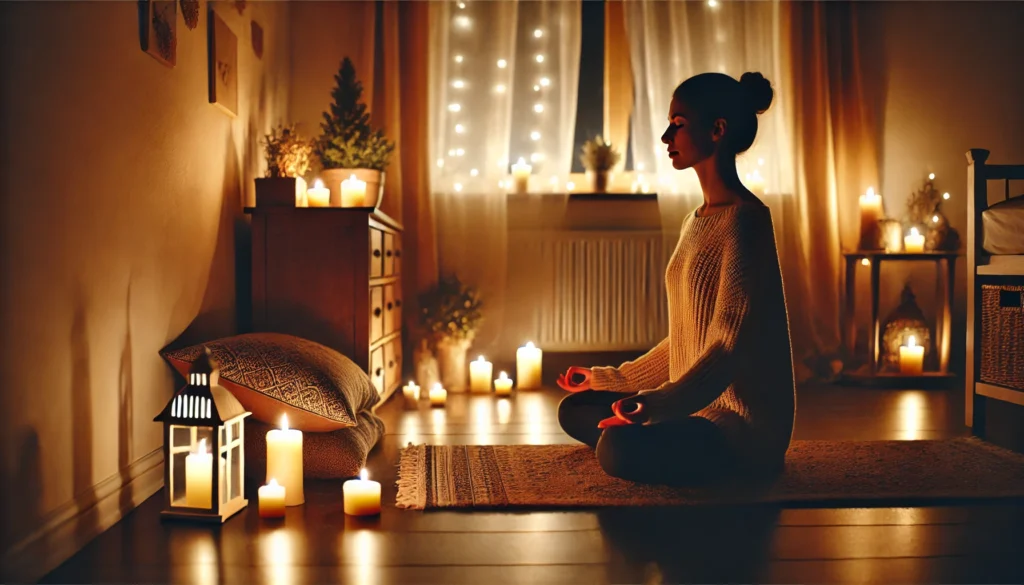Understanding Anxiety and the Need for Holistic Solutions
Anxiety is one of the most common mental health concerns worldwide, affecting millions of individuals across various demographics. It can manifest in a variety of ways, including persistent worry, racing thoughts, physical restlessness, and a heightened stress response. Traditional treatments such as cognitive-behavioral therapy (CBT) and medication are widely used, but many individuals seek alternative or complementary solutions to help manage their symptoms. This growing interest in holistic approaches has led to an increased focus on practices like yoga, meditation, and breathwork, which have been shown to promote relaxation and mental clarity. The question many people ask is: is yoga good for anxiety?
The integration of movement, controlled breathing, and mindfulness in yoga provides a unique method for addressing anxiety. Unlike many other physical activities, yoga places a strong emphasis on the connection between the mind and body. This makes it an effective tool for calming the nervous system and shifting the body away from a constant fight-or-flight response. Numerous studies have explored the relationship between yoga and anxiety, demonstrating that regular practice can contribute to reduced stress levels, enhanced emotional regulation, and an overall sense of well-being. For individuals experiencing symptoms of anxiety, incorporating yoga into a daily or weekly routine can provide a natural way to manage their condition.
You May Also Like: Yoga for Stress Relief: Best Poses to Calm Anxiety and Restore Balance

The Science Behind Yoga’s Impact on Anxiety
Scientific research has increasingly supported the role of yoga in managing mental health conditions, particularly anxiety and depression. One of the primary reasons yoga is effective for anxiety is its ability to activate the parasympathetic nervous system. This system, often referred to as the “rest and digest” response, counteracts the body’s stress-induced fight-or-flight mechanisms. When individuals practice yoga, their heart rate slows, cortisol levels decrease, and their breathing becomes more controlled—all of which contribute to a sense of relaxation and balance.
Additionally, yoga has been shown to increase levels of gamma-aminobutyric acid (GABA), a neurotransmitter that plays a crucial role in calming brain activity. Low levels of GABA are commonly found in individuals with anxiety disorders, and medications such as benzodiazepines are often prescribed to enhance its function. However, research suggests that yoga can naturally boost GABA production, leading to an improved mood and a reduction in anxious thoughts. This biochemical impact is one of the key reasons why yoga and depression management often go hand in hand.
Beyond the neurological benefits, yoga also encourages mindfulness—a practice that has been widely recognized for its ability to reduce stress. Through guided breathing exercises and slow, deliberate movements, yoga practitioners learn to focus on the present moment rather than dwelling on future worries or past regrets. This shift in perspective helps cultivate a more peaceful mental state, making yoga an effective complementary therapy for anxiety.
Does Yoga Work for Anxiety? Examining Real-World Results
The growing popularity of yoga has led many individuals to wonder: does yoga work for anxiety in real-world scenarios? Countless personal accounts, as well as clinical research, suggest that it does. Studies have demonstrated that individuals who practice yoga regularly experience lower levels of stress, fewer symptoms of panic disorder, and improved resilience to everyday challenges. Many yoga practitioners report feeling more grounded, present, and capable of handling stressful situations after engaging in a yoga session.
Incorporating yoga into an anxiety management routine does not require advanced skills or expensive memberships. Even beginners can benefit from basic poses, simple breathwork techniques, and short mindfulness exercises. Unlike high-intensity workouts that can sometimes increase stress levels in individuals prone to anxiety, yoga offers a gentle and adaptable approach that can be modified to suit different needs and physical abilities. This accessibility makes it an appealing option for those looking to take control of their mental health in a natural way.

How Yoga Helps Reduce Stress and Anxiety Symptoms
Yoga’s effectiveness in reducing stress and anxiety lies in its multi-faceted approach. Unlike treatments that focus solely on the mental or physical aspects of anxiety, yoga integrates both, creating a comprehensive method of self-regulation. One of the primary ways yoga accomplishes this is through breath control, or pranayama. Deep breathing exercises, such as diaphragmatic breathing or alternate nostril breathing, help regulate the nervous system, allowing the body to transition into a calmer state.
Additionally, the physical component of yoga aids in releasing stored tension in the muscles. Anxiety often causes physical symptoms such as tight shoulders, neck pain, and headaches. Engaging in yoga poses that target these areas can provide relief and prevent stress from accumulating in the body. The gentle stretching and mindful movements of yoga also improve circulation, further supporting the body’s ability to manage stress and anxiety effectively.
The meditative aspects of yoga also play a crucial role in its impact on mental well-being. Meditation, when combined with yoga, fosters a state of mindfulness that encourages individuals to detach from anxious thoughts and focus on the present. This practice can help break the cycle of rumination, where individuals repeatedly dwell on negative thoughts or worries. As a result, yoga provides both immediate relaxation and long-term mental resilience, making it a valuable tool for those seeking to manage their anxiety naturally.
Yoga and Depression: A Complementary Approach
While much of the focus on yoga has been on its benefits for anxiety, it is also increasingly recognized for its role in managing depression. Yoga and depression research has found that regular practice can lead to improvements in mood, increased energy levels, and a greater sense of emotional stability. The biochemical changes induced by yoga, such as increased serotonin production and improved dopamine regulation, contribute to these positive effects.
Many individuals who struggle with both anxiety and depression find yoga to be a particularly helpful practice, as it addresses multiple facets of mental health simultaneously. For those experiencing symptoms of depression, yoga offers a structured yet gentle form of movement that promotes endorphin release, which is essential for mood regulation. Additionally, the sense of community that often comes with attending yoga classes can provide social support, which is another important factor in mental health management.

Frequently Asked Questions (FAQ) on Yoga for Anxiety and Mental Well-Being
1. Is yoga good for anxiety when combined with other treatment methods?
Yes, yoga can be an effective complement to traditional anxiety treatments such as therapy and medication. Many mental health professionals now recommend integrating yoga into anxiety management plans due to its ability to regulate the nervous system and promote relaxation. Research suggests that yoga enhances the effectiveness of cognitive-behavioral therapy (CBT) by improving emotional regulation and reducing physical symptoms of stress. Additionally, for individuals taking anxiety medication, yoga may help minimize certain side effects by reducing muscle tension and promoting better sleep. While yoga is not a standalone cure, combining it with established treatments can significantly improve overall well-being and resilience against anxiety.
2. Does yoga work for anxiety in high-stress professional environments?
Yoga is particularly beneficial for individuals dealing with workplace stress, as it helps regulate emotional responses and prevent burnout. Many corporate wellness programs have started incorporating yoga and meditation to help employees manage anxiety and improve focus. Even short yoga sessions, such as chair yoga or mindful breathing exercises, can provide immediate relief during a busy workday. Practicing yoga before or after work can also help professionals transition between high-stress environments and personal time more smoothly. By integrating yoga into a daily routine, individuals can develop better coping mechanisms for handling professional pressures.
3. How does yoga and depression treatment complement each other?
Yoga and depression treatment often go hand in hand, as yoga encourages movement, mindfulness, and emotional balance. Depression is commonly linked to reduced serotonin and dopamine levels, and studies show that regular yoga practice can naturally increase these neurotransmitters. Additionally, yoga promotes better sleep patterns, which are often disrupted in individuals with depression. The physical movement in yoga also combats fatigue and improves motivation, two key challenges faced by those experiencing depressive symptoms. While yoga should not replace medical treatment for depression, it can serve as a powerful tool in improving overall mood and mental health.
4. Is yoga good for anxiety if I struggle with traditional meditation?
Yes, yoga can be an excellent alternative for individuals who find traditional seated meditation challenging. Many people with anxiety struggle with stillness, as racing thoughts can become overwhelming during meditation. Yoga offers a moving meditation that combines breath awareness with physical postures, making it easier to stay present. The rhythmic flow of yoga helps quiet the mind without requiring complete stillness, which can be more accessible for individuals with high anxiety levels. Over time, practicing yoga may make it easier to transition into traditional meditation by naturally improving focus and mental clarity.
5. Does yoga work for anxiety better than high-intensity exercise?
Yoga and high-intensity exercise both have benefits for anxiety, but they work in different ways. High-intensity workouts, such as running or weightlifting, release endorphins that create a temporary mood boost. However, they can sometimes elevate cortisol levels, especially in individuals prone to stress. In contrast, yoga activates the parasympathetic nervous system, which promotes long-term relaxation rather than just short-term stress relief. Many individuals find that combining both yoga and more vigorous exercise creates a balanced approach to managing anxiety and overall well-being.
6. How does yoga impact financial stress and decision-making?
Financial stress is a major contributor to anxiety, and yoga can help individuals develop a clearer, more composed mindset when making financial decisions. Anxiety often leads to impulsive spending or avoidance of financial planning, both of which can create long-term stress. Yoga fosters mindfulness, which encourages more intentional decision-making and reduces reactive financial behaviors. Practicing yoga regularly can also improve emotional regulation, making it easier to approach financial challenges with logic rather than fear. While yoga cannot change financial circumstances directly, it can improve one’s ability to manage financial stress effectively.
7. Can yoga help reduce social anxiety?
Yes, yoga can be particularly beneficial for individuals with social anxiety by improving self-confidence and reducing nervous energy. Many people with social anxiety experience physical symptoms such as rapid heartbeat, sweating, or muscle tension, which yoga helps alleviate through controlled breathing and relaxation techniques. Additionally, attending group yoga classes can provide a supportive environment where individuals gradually become more comfortable in social settings. Over time, the mindfulness practices in yoga can help reframe negative thoughts associated with social interactions, making social situations feel less overwhelming. While it may not eliminate social anxiety completely, yoga can make it more manageable.
8. Is yoga good for anxiety if I have trouble sleeping?
Yes, yoga is one of the most effective natural solutions for improving sleep quality. Anxiety often disrupts sleep due to racing thoughts and an overactive nervous system, but yoga helps counteract this by promoting deep relaxation. Specific yoga postures, such as Legs-Up-the-Wall or Child’s Pose, encourage the body to transition into a restful state before bed. Additionally, deep breathing exercises like 4-7-8 breathing can slow the heart rate and prepare the mind for sleep. Practicing yoga consistently can lead to better sleep patterns, which in turn reduces overall anxiety levels.
9. Does yoga work for anxiety differently in men and women?
While yoga benefits both men and women, individuals may experience its effects differently based on biological and psychological factors. Women tend to experience anxiety at higher rates due to hormonal fluctuations, and yoga can help balance cortisol and estrogen levels, reducing mood swings and stress. Men, on the other hand, often hold tension in their upper body and may benefit from yoga’s ability to release muscle tightness and improve flexibility. Additionally, societal expectations often discourage men from seeking mental health support, making yoga a non-stigmatizing way to manage stress and anxiety. Regardless of gender, yoga provides a holistic approach to reducing anxiety that can be tailored to individual needs.
10. How can I integrate yoga into my daily routine for long-term anxiety relief?
The key to long-term anxiety relief through yoga is consistency and accessibility. Start with short sessions, such as 10-15 minutes in the morning or before bed, to build a sustainable habit. Incorporate simple poses like Cat-Cow or Downward Dog throughout the day to relieve tension and prevent stress from accumulating. If finding time for a full class is challenging, use guided yoga videos or mobile apps that offer quick sessions tailored to anxiety relief. Over time, as yoga becomes a regular part of daily life, individuals often experience lasting improvements in stress management and emotional resilience.
Final Thoughts
Yoga has emerged as a highly effective, natural approach for managing anxiety and stress. By integrating movement, breath control, and mindfulness, yoga provides a holistic method for calming the nervous system and promoting mental well-being. Scientific research supports its benefits, demonstrating that regular practice can reduce cortisol levels, increase GABA production, and enhance emotional regulation. These physiological and psychological effects make yoga a valuable tool for those looking to supplement traditional anxiety treatments or find an alternative way to achieve mental balance.
For individuals wondering, “Is yoga good for anxiety?” the answer lies in personal experience and consistency. While yoga may not be a one-size-fits-all solution, its adaptability and accessibility make it a promising option for many. Whether practiced at home, in a studio, or as part of a therapeutic regimen, yoga offers tangible benefits that can help individuals navigate the challenges of anxiety and depression. As interest in holistic mental health solutions continues to grow, yoga is likely to remain at the forefront of effective stress management techniques.
yoga benefits for anxiety, yoga for mental health, stress relief through yoga, how yoga helps anxiety, yoga for emotional well-being, mindfulness and yoga, does yoga work for anxiety, yoga and mental clarity, holistic approaches to anxiety, yoga for stress reduction
Further Reading:
The Effect of Yoga on Stress, Anxiety, and Depression in Women
Yoga for anxiety: a systematic review of the research evidence

